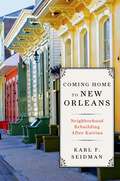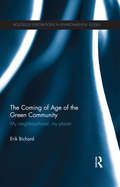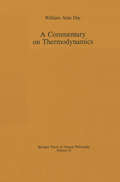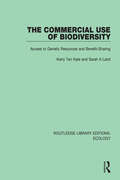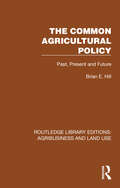- Table View
- List View
Comet/Asteroid Impacts and Human Society: An Interdisciplinary Approach
by Peter T. Bobrowsky Hans RickmanLeading specialists in various disciplines were first invited to a multidisciplinary workshop funded by ICSU on the topic to gain a better appreciation and perspective on the subject of comet/asteroid impacts as viewed by different disciplines. This volume provides a necessary link between various disciplines and comet/asteroid impacts.
Cometary Science after Hale-Bopp: Volume 2 Proceedings of IAU Colloquium 186 21–25 January 2002, Tenerife, Spain
by Hermann Böhnhardt Michael Combi Mark R. Kidger Rita SchulzComet Hale-Bopp defines a milestone event for cometary science: it is the first "really big" comet observed with modern equipment on the ground and from space and due to that; it is considered the new reference object in cometary sciences. At the beginning of a new era in spacecraft exploration of comets and five years after Hale-Bopp's perihelion passage these proceedings of invited and contributed papers for IAU Colloquium 186 "Cometary Science after Hale-Bopp" review the state-of-the-art knowledge on comets, the icy, dusty and most primordial left-overs of the formation disk of our own solar system.
Cometary Science after Hale-Bopp: Volume 1 Proceedings of IAU Colloquium 186 21–25 January 2002, Tenerife, Spain
by Hermann Böhnhardt Michael Combi Mark R. Kidger Rita SchulzComet Hale-Bopp defines a milestone event for cometary science: it is the first "really big" comet observed with modern equipment on the ground and from space and due to that; it is considered the new reference object in cometary sciences. At the beginning of a new era in spacecraft exploration of comets and five years after Hale-Bopp's perihelion passage these proceedings of invited and contributed papers for IAU Colloquium 186 "Cometary Science after Hale-Bopp" review the state-of-the-art knowledge on comets, the icy, dusty and most primordial left-overs of the formation disk of our own solar system. This is the first volume with invited review papers. A second volume with contributed papers is published in ISBN 1-4020-0978-X.
Comets: Nature, Dynamics, Origin, and their Cosmogonical Relevance (Astrophysics and Space Science Library #328)
by Julio A. FernandezComets are small bodies, but of great cosmic relevance. Given its pristine nature, they may preserve valuable and unique information on thechemical and physical processes that took place in theearly solar system, and that may be occurring in the formation of other planetary systems. They might have even played a very important role in the origin of life on Earth. Beyond that, since ancient times comets have inspired awe, superstition, and also curiosity anddebate. Their sudden apparitions challenged the long-held view of the immutability of the heavens, which triggered a long debate on whether comets had a heavenly or terrestrial nature. Therefore, comets have a prominent role in the history of scienti?cthought, that goes back to the most ancient civilizations. The last apparition of comet Halley in 1986 was a landmark since it arouse a great expectation in the scienti?c community and in the public at large. For the ?rst time, a ?otilla of spacecrafts visited a comet. Agreat number of popular and technical books were written on Halley, and comets in general, around the mid-eighties. The interest in comets never subsided after Halley’s passage which is re?ected in the large volume of printed material on these bodies. I have taken the challenge to write a new book on comets that summarizes most of the recent advances on thesubject, including my own workdeveloped during the last 25 years.
Comets and the Origin and Evolution of Life (Advances in Astrobiology and Biogeophysics)
by Paul J. Thomas Roland D. Hicks Christopher F. Chyba Christopher P. McKayThis volume considers the role comets may have played in the origins and evolution of life. This is the only book dealing in depth with this subject. It is particularly relevant in light of recent investigations of Halley's comet, of new insights into organic synthesis in meteorites and comets, and of new results of numerical simulations of cometary orbits and impacts on Earth. The book is intended as a comprehensive review of current research.
Comets in the Post-Halley Era: In Part Based on Reviews Presented at the 121st Colloquium of the International Astronomical Union, Held in Bamberg, Germany, April 24–28, 1989 (Astrophysics and Space Science Library #167)
by R. L. Newburn M. Neugebauer Jürgen H. RaheComets are always very impressive phenomena. Their appearances at regular, but mostly irregular, times excite people who see them. Astronomers have the obvious advantage of being able to see more of comets, and to study them. Their enthusiasm is reflected in the 50 papers in this book, written by more than 90 experts. The reviews in this book clearly describe a landmark in the history of cometary studies. Knowledge gathered up to and including Comet Halley are presented in two volumes. The first volume is about general aspects of observing and studying comets, where they originate and how their evolution develops. The second volume goes into the details of what a comet is: the nucleus, the coma, cometary dust, plasmas and magnetic fields. The book ends with a reflection by Fred Whipple about Comets in the Post-Halley Era. The book discusses all aspects of comets and is therefore suitable for use in graduate level courses. All astronomers and geophysicists interested in comets will find very useful and well-presented information in this book.
Comics as a Research Practice: Drawing Narrative Geographies Beyond the Frame (Routledge Research in Culture, Space and Identity)
by Giada PeterleThis book proposes a novel creative research practice in geography based on comics. It presents a transdisciplinary approach that uses a set of qualitative visual methods, and extends from within the geohumanities across literary spatial studies, comics, urban studies, mobility studies, and beyond. Written by a geographer-cartoonist, the book focuses on ‘narrative geographies’ and embraces a geocritical and relational approach to examine comic book geographies in pursuit of a growing interest in creative, art-based experimental methods in the geohumanities. It explores comics-based research through interconnections between art and geography and through theoretical and methodological contributions from scholars working in the fields of the social sciences, humanities, literary geographies, mobilities, comics, literary studies, and urban studies, as well as from visual artists, comics authors, and art practitioners. Comics are valuable objects of geographical interest because of their spatial grammar. They are also a language particularly suited to geographical analysis, and the ‘geoGraphic novel’ offers a practice of research that has the power to assemble and disassemble new spatial meanings. The book thus explores how the ‘geoGraphic novel’ as a verbo-visual genre allows the study of geographical issues, composes geocentred stories, engages wider and non-specialist audiences, promotes geo-artistic collaboration, and works as a narrative intervention in urban contexts. Through a practice-based approach and the internal perspective of a geographer-cartoonist, the book provides examples of how geoGraphic fieldwork is conducted and offers analysis of the processes of ideation, composition, and dissemination of geoGraphic narratives.
Comics as a Research Practice: Drawing Narrative Geographies Beyond the Frame (Routledge Research in Culture, Space and Identity)
by Giada PeterleThis book proposes a novel creative research practice in geography based on comics. It presents a transdisciplinary approach that uses a set of qualitative visual methods, and extends from within the geohumanities across literary spatial studies, comics, urban studies, mobility studies, and beyond. Written by a geographer-cartoonist, the book focuses on ‘narrative geographies’ and embraces a geocritical and relational approach to examine comic book geographies in pursuit of a growing interest in creative, art-based experimental methods in the geohumanities. It explores comics-based research through interconnections between art and geography and through theoretical and methodological contributions from scholars working in the fields of the social sciences, humanities, literary geographies, mobilities, comics, literary studies, and urban studies, as well as from visual artists, comics authors, and art practitioners. Comics are valuable objects of geographical interest because of their spatial grammar. They are also a language particularly suited to geographical analysis, and the ‘geoGraphic novel’ offers a practice of research that has the power to assemble and disassemble new spatial meanings. The book thus explores how the ‘geoGraphic novel’ as a verbo-visual genre allows the study of geographical issues, composes geocentred stories, engages wider and non-specialist audiences, promotes geo-artistic collaboration, and works as a narrative intervention in urban contexts. Through a practice-based approach and the internal perspective of a geographer-cartoonist, the book provides examples of how geoGraphic fieldwork is conducted and offers analysis of the processes of ideation, composition, and dissemination of geoGraphic narratives.
Coming of Age in Times of Crisis: Youth, Schooling, and Patriarchy in a Venezuelan Town
by J. HurtigComing of Age in Times of Crisis is an anthropological study of the intersecting roles of gender and schooling in the lives of rural Venezuelan youth as they make the transition to adulthood during times of national political and economic crisis. Strongly grounded in local detail while speaking to larger comparative issues and the crises that surround globalization, the study enables us to see how gender roles and social class are reproduced in a culture experiencing profound upheaval, and to see how rural Venezuelans have managed to reproduce and change their culture in these circumstances. This book is based on two-and-a-half years of ethnographic field research Hurtig conducted in the Andean region of Venezuela between 1991 and 1993, and again briefly in 1996.
The Coming of Age of the Green Community: My neighbourhood, my planet (Routledge Explorations in Environmental Studies)
by Erik BichardPeople organising to protect their environment is not a new phenomenon, but the groups that have been pushing for environmental change since the 1970s have not convinced sufficient numbers make sustainable decisions or to lead sustainable lives. Governments have serially failed to do the job at the international level. Now, climate change, resource depletion and widening social aspirations threaten to destabilise human society unless sustainable change can be influenced from another direction. The Coming of Age of the Green Community explores the activities of a new generation of community-led initiatives that may herald the beginnings of the next wave of activism. Erik Bichard combines the testimonies of dozens of group activists with historic evidence and the views of a range of commentators from a variety of disciplines to put forward reasons why some green community groups succeed while others fail. He concludes with a valuable prescription for both existing and emerging groups on how to be sustainable, both over time and in their actions. This book address one of the key questions of the twenty-first century: has the local perspective on this universal concern finally come of age?
The Coming of Age of the Green Community: My neighbourhood, my planet (Routledge Explorations in Environmental Studies)
by Erik BichardPeople organising to protect their environment is not a new phenomenon, but the groups that have been pushing for environmental change since the 1970s have not convinced sufficient numbers make sustainable decisions or to lead sustainable lives. Governments have serially failed to do the job at the international level. Now, climate change, resource depletion and widening social aspirations threaten to destabilise human society unless sustainable change can be influenced from another direction. The Coming of Age of the Green Community explores the activities of a new generation of community-led initiatives that may herald the beginnings of the next wave of activism. Erik Bichard combines the testimonies of dozens of group activists with historic evidence and the views of a range of commentators from a variety of disciplines to put forward reasons why some green community groups succeed while others fail. He concludes with a valuable prescription for both existing and emerging groups on how to be sustainable, both over time and in their actions. This book address one of the key questions of the twenty-first century: has the local perspective on this universal concern finally come of age?
The Coming Wave: The instant Sunday Times bestseller from the ultimate AI insider
by Michael Bhaskar Mustafa Suleyman*An Economist, Financial Times, Guardian, Prospect and Sunday Times Book of the Year*Shortlisted for the FT and Schroders Business Book of the YearThis is the only book you need to understand our new world – from the ultimate AI insider, the CEO of Microsoft AI and co-founder of the pioneering AI company DeepMind.'Important' YUVAL NOAH HARARI'Excellent' BILL GATES'Astonishing' STEPHEN FRY'Stunning' RORY STEWARTSoon you will live surrounded by AIs. In a world of quantum computers, robot assistants and abundant energy, they will organise your life, operate your business, and run government services.None of us are prepared.Mustafa Suleyman has been at the centre of this revolution. The next decade, he explains, will be defined by a wave of powerful, fast-proliferating new technologies. These will create immense prosperity but also present risks.How do we ensure the flourishing of humankind? How do we maintain control over these technologies? And how do we find the narrow path to a successful future? In this groundbreaking book we learn how to think about the essential challenge of our age.Be prepared. Read The Coming Wave.**A New York Times and Instant Sunday Times bestseller, Sept 2023**
Command Companion of Seamanship Techniques
by David HouseThe Command Companion of Seamanship Techniques is the latest work from the well-respected marine author, D J House. It contains all the information needed for command posts at sea.· All aspects of shipboard management are discussed, with special emphasis placed on health and safety.· Guidelines on how to respond to accidents and emergencies at sea· Contains the most recent SOLAS revisions and a discussion of marine law to keep you up to date with the latest rules and regulations.In order to aid learning, the book includes a number of worked examples in the text along with questions and answers at the end of chapters. The author tells you how to respond to accidents and emergencies at sea, in the event, for example of cargo contamination, collision, loss of stability due to cargo shift and damage due to flooding, fire plus loss of life/crew. In addition, the SOLAS revisions and a discussion of marine law is included to keep you up to date with all the latest rules and regulations.In order to aid learning, this book will include a number of worked examples in the text along with questions and answers at the end of chapters.D J House is senior lecturer in Nautical studies at the Nautical college, Fleetwood. His sea-going experience includes general cargo, reefer, bulk cargo, passenger and liner trades, underwater operations, and roll-on/roll-off ferries. He is a well-known marine author and has written Seamanship Techniques Volumes 1 and 2 (combined) and he has revised Cargo Work in the Kemp & Young series.
Command Companion of Seamanship Techniques
by David HouseThe Command Companion of Seamanship Techniques is the latest work from the well-respected marine author, D J House. It contains all the information needed for command posts at sea.· All aspects of shipboard management are discussed, with special emphasis placed on health and safety.· Guidelines on how to respond to accidents and emergencies at sea· Contains the most recent SOLAS revisions and a discussion of marine law to keep you up to date with the latest rules and regulations.In order to aid learning, the book includes a number of worked examples in the text along with questions and answers at the end of chapters. The author tells you how to respond to accidents and emergencies at sea, in the event, for example of cargo contamination, collision, loss of stability due to cargo shift and damage due to flooding, fire plus loss of life/crew. In addition, the SOLAS revisions and a discussion of marine law is included to keep you up to date with all the latest rules and regulations.In order to aid learning, this book will include a number of worked examples in the text along with questions and answers at the end of chapters.D J House is senior lecturer in Nautical studies at the Nautical college, Fleetwood. His sea-going experience includes general cargo, reefer, bulk cargo, passenger and liner trades, underwater operations, and roll-on/roll-off ferries. He is a well-known marine author and has written Seamanship Techniques Volumes 1 and 2 (combined) and he has revised Cargo Work in the Kemp & Young series.
Commemoration as Conflict: Space, Memory and Identity in Peace Processes (Rethinking Peace and Conflict Studies)
by S. McDowell M. BraniffMcDowell and Braniff explore the relationship between commemoration and conflict in societies which have engaged in peace processes, attempting to unpack the ways in which the practices of memory and commemoration influence efforts to bring armed conflict to an end and whether it can even reactivate conflict as political circumstances change.
Commemorative Spaces of the First World War: Historical Geographies at the Centenary (Routledge Research in Historical Geography)
by James Wallis David C. HarveyThis is the first book to bring together an interdisciplinary, theoretically engaged and global perspective on the First World War through the lens of historical and cultural geography. Reflecting the centennial interest in the conflict, the collection explores the relationships between warfare and space, and pays particular attention to how commemoration is connected to spatial elements of national identity, and processes of heritage and belonging. Venturing beyond military history and memory studies, contributors explore conceptual contributions of geography to analyse the First World War, as well as reflecting upon the imperative for an academic discussion on the War’s centenary. This book explores the War’s impact in more unexpected theatres, blurring the boundary between home and fighting fronts, investigating the experiences of the war amongst civilians and often overlooked combatants. It also critically examines the politics of hindsight in the post-war period, and offers an historical geographical account of how the First World War has been memorialised within ‘official’ spaces, in addition to those overlooked and often undervalued ‘alternative spaces’ of commemoration. This innovative and timely text will be key reading for students and scholars of the First World War, and more broadly in historical and cultural geography, social and cultural history, European history, Heritage Studies, military history and memory studies.
Commemorative Spaces of the First World War: Historical Geographies at the Centenary (Routledge Research in Historical Geography)
by James Wallis David C. HarveyThis is the first book to bring together an interdisciplinary, theoretically engaged and global perspective on the First World War through the lens of historical and cultural geography. Reflecting the centennial interest in the conflict, the collection explores the relationships between warfare and space, and pays particular attention to how commemoration is connected to spatial elements of national identity, and processes of heritage and belonging. Venturing beyond military history and memory studies, contributors explore conceptual contributions of geography to analyse the First World War, as well as reflecting upon the imperative for an academic discussion on the War’s centenary. This book explores the War’s impact in more unexpected theatres, blurring the boundary between home and fighting fronts, investigating the experiences of the war amongst civilians and often overlooked combatants. It also critically examines the politics of hindsight in the post-war period, and offers an historical geographical account of how the First World War has been memorialised within ‘official’ spaces, in addition to those overlooked and often undervalued ‘alternative spaces’ of commemoration. This innovative and timely text will be key reading for students and scholars of the First World War, and more broadly in historical and cultural geography, social and cultural history, European history, Heritage Studies, military history and memory studies.
A Commentary on Thermodynamics (Springer Tracts in Natural Philosophy #32)
by William A. DayThe aim of this book is to comment on, and clarify, the mathematical aspects of the theory of thermodynamics. The standard presentations of the subject are often beset by a number of obscurities associated with the words "state", "reversible", "irreversible", and "quasi-static". This book is written in the belief that such obscurities are best removed not by the formal axiomatization of thermodynamics, but by setting the theory in the wider context of a genuine field theory which incorporates the effects of heat conduction and intertia, and proving appropriate results about the governing differential equations of this field theory. Even in the simplest one-dimensional case it is a nontrivial task to carry through the details of this program, and many challenging problems remain open.
The Commerce of Cartography: Making and Marketing Maps in Eighteenth-Century France and England (The Kenneth Nebenzahl Jr. Lectures in the History of Cartography)
by Mary Sponberg PedleyThough the political and intellectual history of mapmaking in the eighteenth century is well established, the details of its commercial revolution have until now been widely scattered. In The Commerce of Cartography, Mary Pedley presents a vivid picture of the costs and profits of the mapmaking industry in England and France, and reveals how the economics of map trade affected the content and appearance of the maps themselves. Conceptualizing the relationship between economics and cartography, Pedley traces the process of mapmaking from compilation, production, and marketing to consumption, reception, and criticism. In detailing the rise of commercial cartography, Pedley explores qualitative issues of mapmaking as well. Why, for instance, did eighteenth-century ideals of aesthetics override the modern values of accuracy and detail? And what, to an eighteenth-century mind and eye, qualified as a good map? A thorough and engaging study of the business of cartography during the Enlightenment, The Commerce of Cartography charts a new cartographic landscape and will prove invaluable to scholars of economic history, historical geography, and the history of publishing.
Commercial Surfactants for Remediation: Mobilization of Trace Metals from Estuarine Sediment and Bioavailability (Advances in Geographical and Environmental Sciences)
by Anu Singh BishtThis book demonstrates the benefits of using commercially available surfactants, or surface-active agents, for remediation of metal-contaminated soil and sediment. First the book offers theoretical reviews of commercially available surfactants, then it proceeds to a study of various available surfactants for the mobilization of metals. Surfactants representative of amphiphiles discovered in the digestive environment of sediment-ingesting organisms are used to examine the extent and rate of metal (Al, Fe, Cd, Cu, Mn, Ni, Pb, Sn, Zn) mobilization from contaminated estuarine sediment. Metals can cause harmful effects to the environment and organisms. It is difficult to treat contaminants that are often tightly bound to the extremely small size of the estuarine sediments.The book also demonstrates the mechanisms of metal mobilization that appear to be related to complexation with monomers and adsorption to micelles of the anionic amphiphiles, and to the denudation of hydrophobic host phases or coatings on the sediment by micelles of both anionic and nonionic surfactants.Readers obtain a better understanding of current commercial surfactants, their impact on the environment, and possible remediation. This transdisciplinary book contributes toward Sustainable Development Goals numbers 6 (Clean Water and Sanitation) and 13 (Climate Action) set by the United Nations and is useful for students and teachers of sediment studies, coastal studies, environmental sciences, hydrology, civil engineering, and policy sciences.
The Commercial Use of Biodiversity: Access to Genetic Resources and Benefit-Sharing (Routledge Library Editions: Ecology #15)
by Kerry Ten Kate Sarah A LairdOriginally published in 1999 The Commercial Use of Biodiversity examines how biodiversity and the genetic material it contains are now as valuable resources. Access to genetic resources and their commercial development involve a wide range of parties such as conservation and research institutes, local communities, government agencies and companies. Equitable partnerships are not only crucial to conservation and economic development but are also in the interests of business and often required by law. In this authoritative and comprehensive volume, the authors explain the provisions of the Convention on Biological Diversity on access and benefit-sharing, the effect of national laws to implement these, and aspects of typical contracts for the transfer of materials. They provide a unique sector-by-sector analysis of how genetic resources are used, the scientific, technological and regulatory trends and the different markets in Pharmaceuticals, Botanical Medicines, Crop Development, Horticulture, Crop Protection, Biotechnology (in fields other than healthcare and agriculture) and Personal Care and Cosmetics Products. This will be an essential sourcebook for all those in the commercial chain, from raw material collection to product discovery, development and marketing, for governments and policy-makers drafting laws on access and for all the institutions, communities and individuals involved in the conservation, use, study and commercialisation of genetic resources.
The Commercial Use of Biodiversity: Access to Genetic Resources and Benefit-Sharing (Routledge Library Editions: Ecology #15)
by Kerry Ten Kate Sarah A LairdOriginally published in 1999 The Commercial Use of Biodiversity examines how biodiversity and the genetic material it contains are now as valuable resources. Access to genetic resources and their commercial development involve a wide range of parties such as conservation and research institutes, local communities, government agencies and companies. Equitable partnerships are not only crucial to conservation and economic development but are also in the interests of business and often required by law. In this authoritative and comprehensive volume, the authors explain the provisions of the Convention on Biological Diversity on access and benefit-sharing, the effect of national laws to implement these, and aspects of typical contracts for the transfer of materials. They provide a unique sector-by-sector analysis of how genetic resources are used, the scientific, technological and regulatory trends and the different markets in Pharmaceuticals, Botanical Medicines, Crop Development, Horticulture, Crop Protection, Biotechnology (in fields other than healthcare and agriculture) and Personal Care and Cosmetics Products. This will be an essential sourcebook for all those in the commercial chain, from raw material collection to product discovery, development and marketing, for governments and policy-makers drafting laws on access and for all the institutions, communities and individuals involved in the conservation, use, study and commercialisation of genetic resources.
The Common Agricultural Policy: Past, Present and Future (Routledge Library Editions: Agribusiness and Land Use #14)
by Brian E. HillOriginally published in 1984, this book provides an introduction to the history of agriculture in Western Europe, states the case for government intervention and analyses the operation of the Common Agricultural Policy (CAP) during the late 20th Century. It concludes that the costs of the policy fell heavily on the poorer consumers, food prices were artificially high and surpluses sold at a loss on the world markets. In the light of Britain’s departure from the EU and the EU CAP this book, which also examined the prospects for the future has an enduring relevance.
The Common Agricultural Policy: Past, Present and Future (Routledge Library Editions: Agribusiness and Land Use #14)
by Brian E. HillOriginally published in 1984, this book provides an introduction to the history of agriculture in Western Europe, states the case for government intervention and analyses the operation of the Common Agricultural Policy (CAP) during the late 20th Century. It concludes that the costs of the policy fell heavily on the poorer consumers, food prices were artificially high and surpluses sold at a loss on the world markets. In the light of Britain’s departure from the EU and the EU CAP this book, which also examined the prospects for the future has an enduring relevance.







